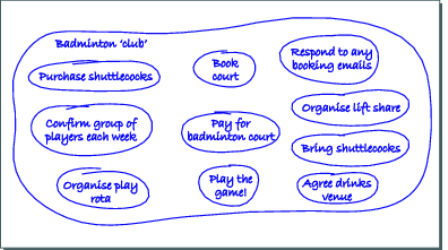1.1 Organisations and purpose
If organisations are defined as groups of people organised for an agreed purpose, determining purpose becomes central to understanding their structure and the ways in which an organisation might act, with implications for innovation and environmental management.
Activity 2 Purpose
Identify the different purposes of the organisations you considered while developing your answer for Activity 1.
Provide your answer...
Discussion
My employer’s stated purpose is to provide students with learning opportunities; my family’s purpose is to provide a support and learning structure for those in it; the sports group’s purpose could be to engage in a mix of socialising and exercise; the retail store’s and bank’s purpose could be defined as profit-orientated through provision of goods and services.
Your answer may have included all kinds of organisations for many different purposes, perhaps a local shop or garage or an online retailer, a global corporation or a small local volunteer or charity group. These descriptions give some clue to their purpose.
However, there is often some tension encountered about whether an organisation’s stated purpose maps directly to any individual working within an organisation. For example, you may have come across the story of the architect Christopher Wren when he was surveying the rebuilding of St Paul’s Cathedral after the Great Fire of London in 1666. Paraphrased, on encountering three stonemasons working on the rebuilding, he asked each the same question: ‘What are you doing?’ The reply from the first was ‘I’m working’, the second, ‘I’m building a wall’, and the third replied ‘I’m building a cathedral to God’.
Looking back at the earlier definition of organisations and its emphasis on agreed purpose, would you say these stonemasons were all part of the same organisation? There is some room for debate here and it depends, in part, on where you draw the boundary between an organisation’s purpose and the activities engaged in by individual members of an organisation to fulfil that purpose.
Your own assessment of organisations should reveal that not everyone in any organisation is doing the same thing all the time. Roles and responsibilities and thus activities differ, but they can still contribute to the overall purpose of the organisation. In one view, all three stonemasons are part of the same organisation: they are still involved in the building of a cathedral, even if their individual sense of purpose differs. In other words, people within organisations can have ‘nested’ sets of purpose which can still (but not necessarily always) contribute to the overall purpose. If someone starts to engage in activities that contravene, or are separate from, the organisation’s overall purpose, then we might consider that they don’t belong to the organisation.
Activity 3 Systems map of purpose
Taking one of the organisations familiar to you, identify the main purpose of the organisation, then draw a systems map to identify the different activities undertaken within the organisation to achieve that purpose.
(Note: guidance on drawing systems maps is available in the Systems diagramming [Tip: hold Ctrl and click a link to open it in a new tab. (Hide tip)] course and on the Guide to diagrams.)
Discussion
I’ve chosen the informal badminton club I belong to. It is less of a club, more of an informal group of friends. The main purpose is to play badminton for enjoyment and socialising. My systems map shows the main activities associated with this purpose. Not everyone does all of the activities all of the time, but they are necessary to enable the organisation to function.
Your answer should reveal a fairly diverse set of activities within the organisation, even if these are performed by a small number of individuals.
The overall purpose of the organisation is likely to fall into one of three broad categories:
- some organisations exist to make a profit
- some to affect public interests in the form of governance, such as a local authority or regulator
- some to fulfil an identified need that is non-profit-making, such as a social group, charity or non-governmental organisation.
While there are many variants and overlaps between these broad distinctions, and numerous academic books and discussions about the nature of organisations, the above definition of organisations and awareness of purpose offers a working understanding of organisations that provides the basis for exploring the way organisations engage in environmental management in this course.

